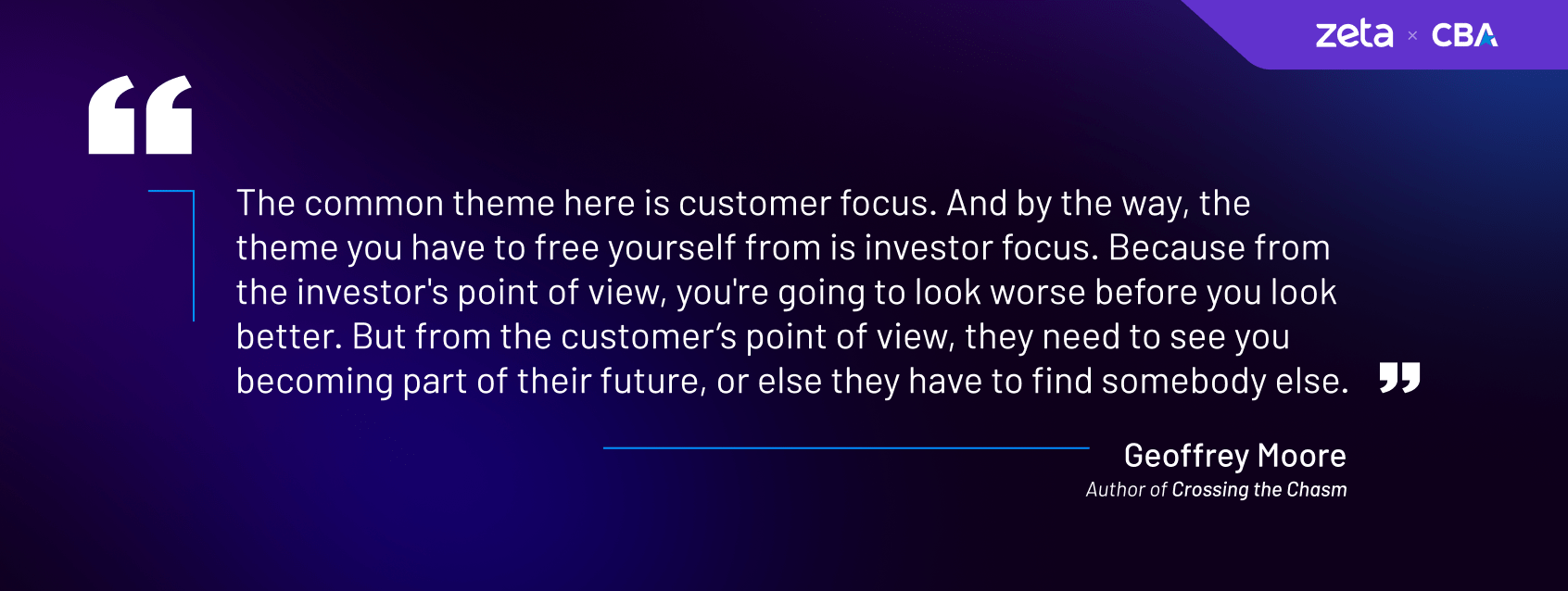Why Financial Institutions Fail to Modernize and How to Fix It

I recently had the privilege of conversing with Geoffrey Moore, author of Crossing the Chasm and one of the foremost experts on innovation, on one of the most pressing challenges facing financial institutions today: failure to modernize. The conversation drew from both Zeta’s experiences with modernization initiatives at financial institutions, and what lessons can we take from Geoffrey’s experiences with other industries in modernization.
If you’d like to hear the full conversation, watch our webinar, Why Banks Fail at Modernization. But in the meantime, here are some key insights worth delving into:
- Financial Institutions Are Not Alone
- The Four Zones of Transformation
- Lessons from the Incubation Zone
- Technology Debt: A Major Barrier
- Why Transformation Teams Don’t Work
- Siloed Operations and C-Suite Buy-In
- Culture: The Driving Force Behind Modernization
- The Road Ahead for Financial Institutions
Financial Institutions Are Not Alone
Geoffrey and I discussed how modern experiences are disrupting all industries with varying velocities, including ones that are highly regulated. There are success stories of incumbents successfully defending their market and we’ve all seen industries where change happens so quickly that incumbents cannot effectively respond and lose dramatic market share.
Geoffrey has consulted with some of the biggest names in business on how to respond to disruption, including disruptors like Salesforce, and companies successfully defending against disruption like Microsoft. He has distilled his insights in his book Zone to Win, which is particularly useful for the banking industry.
The Four Zones of Transformation
Geoffrey’s Zone to Win framework divides a company’s operations into four distinct zones, each critical to balancing short-term success with long-term growth. Here’s a quick overview:
- Performance Zone – The bread and butter. This zone is where your profits come from and sustains your business.
- Productivity Zone – This is where companies optimize compliance, operations, and expense management. It’s about doing more with less.
- Incubation Zone – The most misunderstood zone, where companies experiment and innovate to find future drivers of growth.
- Transformation Zone – This is where you scale successful innovations into profitable ventures. Speed is key in this zone.
Geoffrey emphasized the importance of understanding how these zones operate and that most financial institutions struggle the most in the Incubation and Transformation Zones.
Geoffrey emphasized the importance of understanding how these zones operate and that most financial institutions struggle the most in the Incubation and Transformation Zones.

Lessons from the Incubation Zone
Geoffrey and I spent a significant part of our conversation discussing the Incubation Zone, which is often the most mismanaged zone. Many banks view it as a “corporate entertainment” zone rather than a critical driver of future growth. Here’s what financial institutions need to know about succeeding in the Incubation Zone:
- Incubation is not about ROI. Instead, it’s about customer experience and adoption. Success in this zone is determined by whether customers want to engage with what you’re offering.
- Scale is the enemy in this zone. Scaling should only happen in the Transformation Zone; here, the focus is on finding viable products or services.
- Take risks. Banks are often risk-averse, but the Incubation Zone is where risk-taking is necessary to reduce the time to market. As Geoffrey put it, “The incubation zone takes extra risk to reduce time.”
- Failure is an option. In the Incubation Zone, failure should be expected. The goal is to fail fast and learn quickly.
Technology Debt: A Major Barrier
Every financial institution struggles with technology debt—outdated systems that still play a critical role in operations. Geoffrey described it as “cholesterol in the arteries.” Many institutions are running on 30-year-old systems that haven’t been fully mapped out, making modernization almost impossible without addressing this tech debt head-on.
The challenge here is that banks often don’t fully understand the scale of their tech debt, which hinders their ability to move forward. As Geoffrey pointed out, fintechs can launch a new product in four weeks, but for traditional banks, it can take six months to a year. This lag is largely due to their reliance on legacy systems.
Why Transformation Teams Don’t Work
A key point that Geoffrey raised was that many banks create transformation teams, but these teams often fail because they’re isolated from the rest of the organization. Transformation cannot happen in a silo. Instead, Geoffrey recommends that banks create an independent business unit (BU) dedicated to innovation. This unit can later be integrated into the broader organization once the innovations have been proven and scaled.
Siloed Operations and C-Suite Buy-In
Geoffrey and I also touched on the challenge of siloed operations within financial institutions. Even with a transformation team in place, banks often struggle to get buy-in from different business units. This creates fragmented execution, where the digital layer may appear cohesive, but the underlying units continue to operate in silos.
Securing C-Suite buy-in and breaking down silos are critical to the success of any transformation. Without alignment from the top, these efforts are likely to stall.
Culture: The Driving Force Behind Modernization
Finally, we discussed the importance of culture in driving modernization. As Geoffrey noted, a culture focused on internal success rather than customer success will always struggle to innovate. Banks need to foster a competitive or customer-centric culture, ensuring that the organization is driven by the needs of its customers rather than its own internal processes.
Geoffrey was clear: creating the right culture may involve making difficult decisions, such as firing senior executives who are not aligned with the company’s transformation goals. While this can be challenging, it’s essential for long-term success.
The Road Ahead for Financial Institutions
The path to modernization is challenging, but it’s not impossible. Geoffrey’s insights are crucial for financial institutions to navigate the complexities of transformation. By understanding the four zones, addressing technology debt, and fostering the right culture, banks can position themselves for future success.
Again, I encourage you to watch the entire conversation here.
If your institution is grappling with these challenges, I’d love to continue the conversation. Let’s explore how your bank can overcome these hurdles and unlock the potential for future growth.



